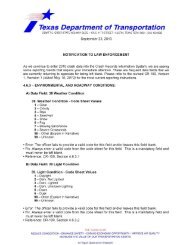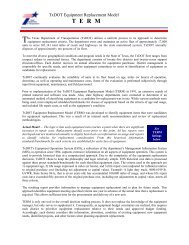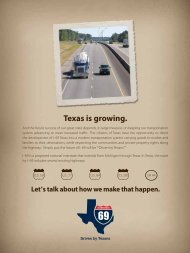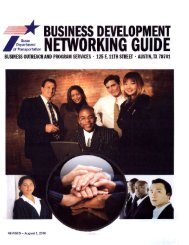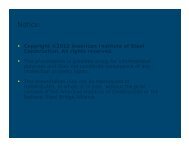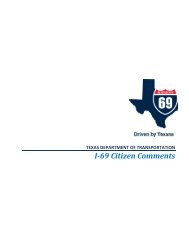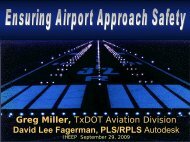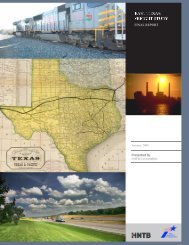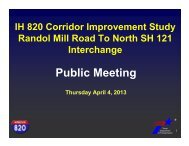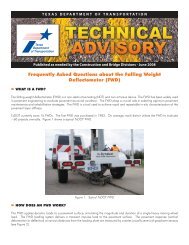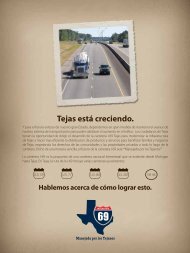TxDOT has a Plan - Welcome to the Texas Department of ...
TxDOT has a Plan - Welcome to the Texas Department of ...
TxDOT has a Plan - Welcome to the Texas Department of ...
You also want an ePaper? Increase the reach of your titles
YUMPU automatically turns print PDFs into web optimized ePapers that Google loves.
OUR<br />
Strategic <strong>Plan</strong><br />
To ensure that <strong>the</strong> state continues <strong>to</strong> enjoy<br />
<strong>the</strong> economic benefits <strong>of</strong> a well-designed<br />
transportation network, we evaluate projects<br />
on <strong>the</strong> basis <strong>of</strong> <strong>the</strong>ir economic impacts.<br />
Our Economic Opportunity Index calculates<br />
<strong>the</strong> travel-time savings realized from an<br />
expansion project, as well as <strong>the</strong> economic<br />
penalty that could result from inaction.<br />
Through <strong>the</strong> index, a project’s contribution <strong>to</strong><br />
<strong>Texas</strong>’ global competitiveness will be fac<strong>to</strong>red<br />
in<strong>to</strong> transportation investment decisions.<br />
GOAL 4:<br />
Improve air quality<br />
In <strong>the</strong> urban areas <strong>of</strong> our state, concentrations<br />
<strong>of</strong> emissions from au<strong>to</strong>motive exhaust pose a<br />
potential threat <strong>to</strong> human health. To improve<br />
<strong>the</strong> overall air quality in <strong>the</strong> state, we must<br />
encourage transportation alternatives, assist<br />
efforts <strong>to</strong> reduce <strong>the</strong> overall emissions rates<br />
<strong>of</strong> vehicles, and reduce <strong>the</strong> time vehicles<br />
spend idling.<br />
Because vehicles produce substantially higher<br />
levels <strong>of</strong> pollution when running at low speeds,<br />
we can reduce vehicle emissions by reducing<br />
<strong>the</strong> percentage <strong>of</strong> time cars spend idling.<br />
For example, adding capacity <strong>to</strong> highways<br />
with new lane miles would reduce <strong>the</strong> time<br />
mo<strong>to</strong>rists spend in gridlock conditions, which<br />
could substantially lower <strong>the</strong> release <strong>of</strong><br />
harmful pollutants like carbon monoxide.<br />
Improvements <strong>to</strong> rail crossings could eliminate<br />
vehicle s<strong>to</strong>pping, which would help <strong>to</strong> reduce<br />
harmful emissions and keep traffic flowing.<br />
Whenever we weigh <strong>the</strong> benefit and cost <strong>of</strong><br />
a new project, we examine its likely impact<br />
on air quality. We do this by calculating <strong>the</strong><br />
change in average speed and/or reduction in<br />
idling that will result from <strong>the</strong> project, which<br />
allows us <strong>to</strong> gain a more complete picture <strong>of</strong><br />
how transportation investments affect <strong>the</strong><br />
quality <strong>of</strong> life for Texans.<br />
GOAL 5:<br />
Increase <strong>the</strong> value <strong>of</strong><br />
transportation assets<br />
Traditionally, roads have been paid for from<br />
revenue generated from <strong>the</strong> state’s fuel tax<br />
and <strong>Texas</strong>’ portion <strong>of</strong> <strong>the</strong> federal fuel tax.<br />
However, with a system currently at nearly<br />
80,000 centerline miles, <strong>the</strong> majority <strong>of</strong> our<br />
fuel-tax dollars go for maintenance costs, at<br />
<strong>the</strong> expense <strong>of</strong> new mobility projects.<br />
Our asset-value approach resolves this conflict<br />
in several ways. By <strong>to</strong>lling new high-traffic<br />
projects, we can get capacity built in <strong>the</strong> areas<br />
that need <strong>the</strong>m faster and without tapping<br />
limited fuel-tax dollars. Currently, we are<br />
devising a way <strong>to</strong> measure a facility’s value as<br />
an asset, which will ultimately help us <strong>to</strong> chart<br />
our progress in <strong>the</strong> achievement <strong>of</strong> this goal.<br />
Our Goals<br />
Additionally, when a <strong>to</strong>lled project is built, it<br />
preserves <strong>the</strong> value <strong>of</strong> our system by diverting<br />
traffic away from existing roadways, <strong>the</strong>reby<br />
reducing wear-and-tear maintenance costs on<br />
<strong>the</strong> existing system. A <strong>to</strong>ll project will pay for<br />
its own maintenance as well as generating<br />
additional funds for o<strong>the</strong>r needed mobility<br />
projects in <strong>the</strong> area.<br />
This allows us <strong>to</strong> develop a comprehensive<br />
maintenance plan that will preserve our system<br />
longer. That means fewer potholes, fewer<br />
cracks, fewer <strong>to</strong>tal road reconstructions due <strong>to</strong><br />
delays in maintenance from a lack <strong>of</strong> funding.<br />
In o<strong>the</strong>r words, we will not only gain more<br />
capacity, but <strong>the</strong> infrastructure we already have<br />
will be better maintained and more valuable<br />
and functional <strong>to</strong> users <strong>of</strong> <strong>the</strong> system.<br />
3. Expand economic opportunity<br />
• creating new trade and transport corridors • adding capacity <strong>to</strong> highways <strong>to</strong> reduce congestion<br />
• empowering local and regional leaders <strong>to</strong> make local and regional transportation decisions<br />
• providing <strong>to</strong>lled lanes that allow businesses <strong>to</strong> make deliveries more efficient and get employees <strong>to</strong> work faster<br />
• improving rail lines and crossings <strong>to</strong> move goods more quickly and attract trade<br />
4. Improve air quality<br />
• using public transportation / carpools • using alternative fuels in <strong>the</strong> <strong>TxDOT</strong> fleet<br />
• creating High Occupancy Vehicle (HOV) lanes • adding capacity <strong>to</strong> highways <strong>to</strong> reduce idling<br />
• improving railroad crossings <strong>to</strong> prevent vehicle s<strong>to</strong>pping<br />
5. Increase <strong>the</strong> value <strong>of</strong> transportation assets<br />
• creating parallel corridors <strong>to</strong> alleviate traffic burden • using existing footprints for new capacity<br />
• improving and maintaining existing roadways • investing transportation dollars where <strong>the</strong>y’re most needed<br />
9




